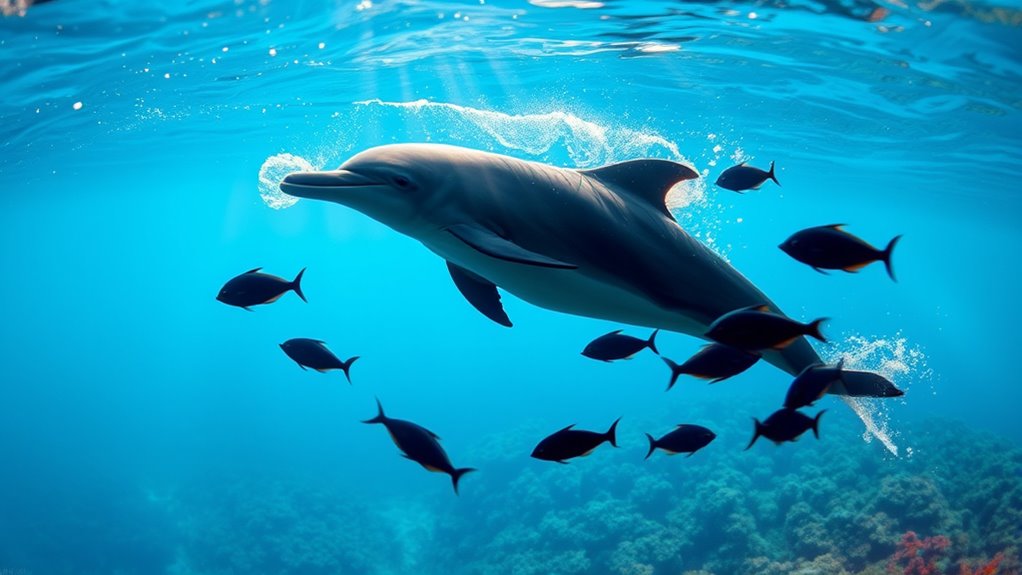Animals use sound for survival in various essential ways. They communicate with each other to establish territory, attract mates, and maintain social structures. Echolocation helps many animals, like bats and dolphins, navigate and hunt in darkness. Fish and invertebrates produce sounds to signal danger or provide cleaning services. Sound also influences habitat selection, especially in reef environments. By understanding how sound plays a role in animal survival, you can gain deeper insights into these fascinating adaptations.
Key Takeaways
- Marine animals rely on sound for communication, aiding in reproduction and territorial claims essential for survival.
- Echolocation allows bats and dolphins to navigate and hunt effectively in low-light environments.
- Fish and invertebrates use sounds to attract mates, establish territory, and signal cleaning services to maintain ecological balance.
- Acoustic interactions influence predator-prey dynamics, helping animals evade threats or locate prey through sound signals.
- Low-frequency sounds transmit over long distances, facilitating communication across vast marine ecosystems and enhancing survival strategies.
The Role of Sound in Animal Communication

Sound plays an essential role in how animals communicate, especially in the underwater world where visibility is often limited. Marine animals, like dolphins and whales, rely on sound for communication, navigation, and locating food.
You'll notice they produce sounds with varying pitch and structure, each conveying different messages. Fish and marine invertebrates also use sound; for instance, they grunt and click to attract mates, ward off predators, or establish territory.
Coral reef fish larvae depend on underwater sounds to find suitable habitats, guided by distinct acoustic signatures. In social species like dolphins, using sound helps maintain group structure and coordinate behaviors within their pods, emphasizing the critical nature of sound in their survival and social interactions.
Echolocation: Nature's Sonar

Echolocation serves as nature's sophisticated sonar, allowing animals like bats and dolphins to navigate and hunt with remarkable accuracy. By emitting sound waves, these creatures can determine the size, shape, and distance of objects around them, making echolocation incredibly effective in dark or murky environments.
| Animal | Sound Frequency (Hz) | Hunting Ability |
|---|---|---|
| Bats | >100,000 | Detects objects as small as a human hair |
| Dolphins | Varies (up to 150,000) | Creates acoustic images of surroundings |
| Whales | 10,000 – 100,000 | Locates prey underwater with precision |
This biological sonar not only enhances their hunting strategies but also showcases their remarkable evolutionary adaptation to their environments.
Sound Production in Fish and Invertebrates

When you think about underwater communication, fish and invertebrates have some fascinating techniques.
Fish use sounds like grunts and clicks to attract mates or ward off threats, while invertebrates like lobsters and fiddler crabs utilize sound for courtship and territorial claims.
These strategies showcase the critical role of sound in the survival of these aquatic creatures.
Fish Communication Techniques
While you might think of fish as silent swimmers, they actually produce a fascinating array of sounds that play vital roles in their survival. Many fish, like the big eye scad, use their pharyngeal teeth to create distinctive grunts and clicks, communicating for various purposes such as attracting mates or deterring predators.
These frequency sounds are essential in social interactions, influencing behaviors linked to reproduction and territoriality. Cleaner shrimp also participate in this acoustic world, clapping their claws to signal their cleaning services to reef fish, establishing mutualistic relationships.
Though not all fish use echolocation like some marine mammals, the sounds they produce highlight how animals use sound to navigate their environments and enhance their survival strategies.
Invertebrate Sound Strategies
Invertebrates, like spiny lobsters and fiddler crabs, may not be as vocal as fish, but they still employ a range of sound strategies for communication and survival.
These creatures use sound in a variety of ways, often at low frequencies, to convey important messages. Here are some notable strategies:
- Spiny lobsters create sounds by rubbing their claws together for defense and courtship.
- Fiddler crabs use body movements to generate acoustic signals during mating rituals.
- Cleaner shrimp clap their claws to signal their cleaning services to reef fish.
- Big eye scad produce distress sounds with their pharyngeal teeth when threatened.
Sound production in marine invertebrates remains an emerging field, with much yet to discover.
The Importance of Sound in Marine Ecosystems

Sound plays an essential role in marine ecosystems, affecting everything from communication to navigation. In the ocean, sound travels over four times faster than in air, making it crucial for marine animals.
You'll find that fish and marine mammals depend on sound for reproduction and territorial claims. Humpback whales, for example, create intricate songs that can travel thousands of kilometers.
Echolocation, used by dolphins and sperm whales, helps them detect and characterize objects, allowing precise prey location. Additionally, coral reef fish larvae utilize unique sound signatures to find suitable habitats, guiding their settlement.
Even invertebrates like cleaner shrimp and spiny lobsters produce sounds for defense and courtship, showcasing the diverse roles sound plays in the marine environment.
How Sound Affects Habitat Selection

As coral reef fish larvae search for suitable habitats, they rely heavily on the underwater sound cues that their environment provides.
Sound plays a significant role in guiding their orientation during settlement, leading them to the best environments for growth and survival.
Sound significantly guides coral reef fish larvae in their settlement, directing them toward optimal growth and survival habitats.
Here are some key points about how sound influences habitat selection:
- Unique sound signatures are produced by different coastal ecosystems.
- Reef-generated noise attracts larvae, increasing their chances of settling successfully.
- Acoustic environments impact behavioral plasticity in larval reef fish.
- Understanding sound's role in habitat selection aids conservation efforts.
- Preserving natural acoustic environments is essential for the survival of these species.
Predator-Prey Dynamics: The Sound Connection

The intricate relationship between predator and prey often hinges on acoustic interactions that can determine survival outcomes. You might notice that many animals use sound to communicate about danger. For instance, birds emit alarm calls to warn their flock of lurking predators.
Similarly, tiger moths produce clicking sounds to disrupt bat echolocation, allowing them to escape. Pistol shrimp make the loudest sound in the animal kingdom, stunning prey and deterring threats with their claw snaps.
Killer whales use strategic sound waves from tail slaps to stun fish while hunting. Additionally, sound mimicry, like clearwing moths imitating honey bee buzzing, helps animals avoid detection.
These sound strategies highlight the critical role of acoustics in predator-prey dynamics.
Unique Sound Adaptations Across Species

When you explore the unique sound adaptations across species, you'll see how animals use sound in fascinating ways to survive.
Marine mammals like dolphins rely on echolocation to navigate and hunt, while other creatures develop communication strategies through distinct sounds.
These adaptations not only help them find food but also play essential roles in predator-prey interactions.
Echolocation in Marine Mammals
While exploring the underwater domain, you'll discover that marine mammals like dolphins and sperm whales have developed incredible adaptations for survival, particularly through echolocation.
This sophisticated ability allows them to emit clicks and analyze returning echoes, which helps them navigate and hunt efficiently.
Here are some fascinating aspects of echolocation in these creatures:
- Frequency Range: Dolphins produce clicks between 20 kHz and 150 kHz for detailed target analysis.
- Visibility: Echolocation shines in murky waters, where sight is often limited.
- Loud Clicks: Sperm whales can emit clicks up to 230 decibels for long-distance communication and navigation.
- Unique Evolution: Different species adapt their echolocation to fit their ecological niches.
- Prey Detection: It helps them identify prey size, shape, and distance accurately.
Sound Communication Strategies
Sound plays an essential role in the survival of many species, as diverse animals employ unique vocalizations and sound adaptations to communicate in their environments. For instance, dolphins and whales use complex vocalizations and echolocation to navigate vast underwater distances. Fish like the big eye scad produce sounds with specialized structures to attract mates. Meanwhile, spiny lobsters and fiddler crabs create sounds for defense and courtship. Coral reef fish larvae rely on distinct sound signatures to find suitable habitats. Elephants use low-frequency infrasound, traveling over 10 kilometers, to maintain social bonds.
| Species | Sound Communication Strategy |
|---|---|
| Dolphins & Whales | Echolocation and complex vocalizations |
| Big Eye Scad | Sounds to attract mates |
| Spiny Lobsters | Sounds for defense and courtship |
| Coral Reef Fish | Distinct sound signatures for habitat location |
| Elephants | Low-frequency infrasound for social bonding |
Predator-Prey Interaction Sounds
Animals not only use sound for communication but also as a tool for survival in predator-prey interactions.
You'd be amazed at the unique adaptations that help them evade capture or deter threats:
- Bats and tiger moths use echolocation, with moths clicking to disrupt bat sonar.
- The pistol shrimp produces a deafening 218-decibel sound to stun prey and scare off predators.
- Elephants communicate using infrasound, warning others of danger from up to 10 kilometers away.
- Some frogs balance safety and mating by using unique calls that attract mates while signaling their location to predators.
- Clearwing moths mimic honey bee buzzing to create the illusion of being dangerous.
These adaptations showcase the incredible ways sound shapes survival in the wild.
The Science of Sound Transmission in Water

In the vast underwater world, the transmission of sound plays an essential role in how marine life communicates and navigates. Sound travels over four times faster in water than in air, thanks to water's incompressibility. This speed allows aquatic animals to send messages and find their way over long distances efficiently.
Low-frequency sounds, like those from humpback whales, can travel thousands of kilometers, making them ideal for long-range communication. In contrast, high-frequency sounds lose energy quickly and can bounce off obstacles, prompting many marine species to favor low frequencies for communication and echolocation.
Think of it like jumping on a bouncy castle versus a water balloon; sound waves behave differently in water, enhancing underwater communication and social interaction.
Interactive Learning: Engaging With Animal Sounds

You can explore the fascinating ways animals use sound through interactive games that mimic their communication and hunting tactics.
For instance, understanding echolocation helps you appreciate how bats and dolphins find food while steering through their environments.
Sound-Based Communication Strategies
While exploring the animal kingdom, you'll discover that sound plays an essential role in survival strategies. Various species utilize sound-based communication to thrive in their environments:
- Marine mammals like dolphins and whales use intricate songs to communicate over vast distances, with frequencies ranging from 40 Hz to 4,000 Hz.
- Fish produce grunts, croaks, and clicks to attract mates and establish territories.
- Coral reef fish larvae are guided to habitats by distinct underwater sound signatures.
- Elephants communicate using infrasound, transmitting messages over 10 kilometers to maintain social structures.
- Interactive learning games like "Bats and Bugs" help illustrate these sound communication strategies, emphasizing their importance in the animal kingdom.
Understanding these strategies enhances your appreciation of the diverse ways animals navigate their worlds.
Echolocation: Hunting Techniques
Echolocation serves as a remarkable hunting technique employed by various animals, enabling them to thrive in their environments. Bats and dolphins are prime examples, using sound waves to detect prey and navigate challenges. Bats emit high-frequency sounds over 100,000 Hz, allowing them to hunt in complete darkness. Dolphins, on the other hand, produce clicks to locate fish in murky waters.
Here's a quick comparison:
| Animal | Sound Frequency | Hunting Efficiency |
|---|---|---|
| Bats | >100,000 Hz | Navigate and catch prey |
| Dolphins | Clicks (varied) | Locate fish, navigate waters |
| Sperm Whales | Up to 230 decibels | Communicate and hunt across vast distances |
These techniques showcase the significance of echolocation in survival strategies.
Interactive Sound Games
Interactive sound games offer a fun and engaging way to explore how animals use sound in their survival strategies. These activities enhance your understanding of animal communication while keeping you actively involved.
Here are some games you can try:
- Bats and Bugs: Blindfolded participants act as bats, using sound to locate "bugs" that respond with noises.
- Predator-Prey: Prey animals create sounds (like shaking containers) to evade predators, showcasing the importance of auditory signals.
- Time Challenges: Set time limits to keep participants engaged and focused.
- Team Collaboration: Work with others to strategize sound usage in various scenarios.
- Role Reversal: Switch roles to gain perspective on predator and prey dynamics.
These games highlight the complexities of animal behavior and the essential role sound plays in survival.
Exploring Future Research in Animal Sound Use

As researchers investigate the complexities of animal sound use, they're uncovering essential insights that could shape our understanding of marine ecosystems. Future studies will examine how underwater noise pollution disrupts marine species' communication. They'll explore sound frequency and intensity effects on larval fish, revealing settlement patterns in coral reefs.
| Research Focus | Key Species | Expected Outcomes |
|---|---|---|
| Impact of noise pollution | Marine mammals | Enhanced social structure insights |
| Sound frequency effects | Larval fish | Better understanding of habitat selection |
| Bioacoustics of invertebrates | Various invertebrates | New communication dimensions |
| Acoustic sensors technology | All marine species | Improved sound pattern analysis |
| Machine learning applications | Diverse marine life | Uncovering ecological significance |
Through these efforts, you'll witness a richer understanding of sound's role in marine life.
Frequently Asked Questions
How Does Sound Protect Living Things?
Sound protects living things in various ways. It acts as a warning system, alerting others to danger, so they can take cover.
You might notice how certain animals create sounds that disrupt predators' senses, allowing them to escape. Some even mimic the sounds of more dangerous creatures to ward off threats.
How Does Hearing Help Animals Survive?
Hearing helps animals survive by sharpening their senses and signaling safety. When you listen closely, you notice subtle sounds that indicate danger, like rustling leaves or distant growls. This awareness allows you to react quickly and escape threats.
Furthermore, being attuned to your environment helps you locate food and communicate with others in your group. Through keen listening, you enhance your chances of survival and thrive in your habitat.
How Do Animals Use Sound to Hunt?
Animals use sound to hunt by employing techniques like echolocation and specialized vocalizations.
For instance, when you observe bats, they emit high-frequency sounds, bouncing off objects to locate prey in the dark.
Dolphins create clicks and whistles, interpreting echoes to identify shapes and distances in murky waters.
Even owls use their acute hearing to pinpoint prey locations at night.
How Do Animals Use Their Senses to Survive?
Imagine wandering through a dense forest, every rustle and whisper heightening your senses.
Animals use sight, smell, and touch to navigate their world. You might spot a deer, ears perked, listening for predators.
A wolf, with its keen nose, tracks scents left behind. With every sound and scent, they gather vital information, enhancing their survival chances.
It's a constant battle, where their senses are the ultimate tools in the fight for life.
Conclusion
In the grand symphony of nature, sound plays a crucial role in the survival of animals. From the whispers of dolphins to the calls of birds, these creatures harmonize their lives with the environment around them. Understanding how sound shapes their communication, navigation, and habitat choices can deepen your appreciation for the intricate web of life. As we continue to explore these fascinating adaptations, remember that every sound you hear is a note in nature's beautiful melody.










